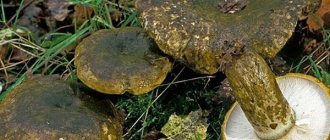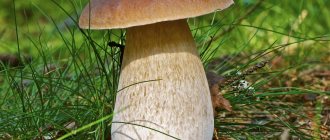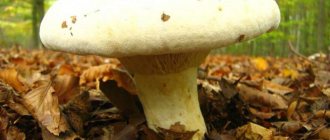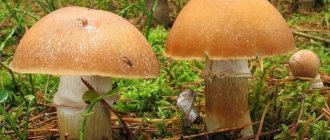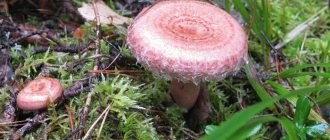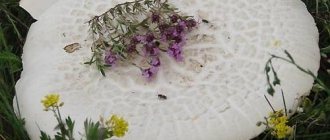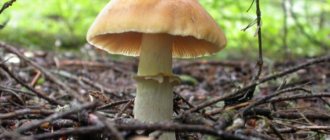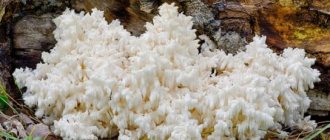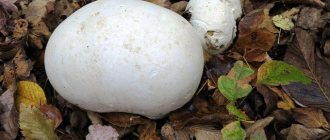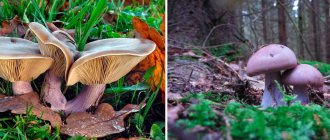Oak breast photo
According to the description, the saffron milk cap differs from the other milk mushrooms in its brick-orange, yellowish-tinged cap color. It has an irregular funnel-shaped shape and slightly lowered and turned-up felt edges. The cap is significant in size and can reach 15–20 cm in diameter, and it also has clearly defined concentric circles, painted in a darker color.
The young mushroom is slightly moist to the touch and becomes sticky in rainy weather. However, on sunny days its surface is completely dry. The leg of the camelina is dense, thick and short, and has a cavity inside. Its length is on average 5–7 centimeters. The fungus is a lamellar fungus, and its reproduction occurs through the spread of spores. The plates located under the cap of the milk mushroom are wide, whitish or orange in color. The flesh of the mushroom is pale pink when broken, with a pleasant aroma.
Description of mushrooms
False milk mushroom is a welcome guest on the holiday table, but not all housewives take up the preparation, preferring more familiar types. The reason for this is the white milky juice contained in the cap and stem, which can take on a yellowish tint in the air and has a sharp-bitter taste.
Real white milk mushrooms are considered the best for pickling.
Etymology of the name
There are different versions:
- The mushroom is named so because of its large weight, at which it appears heavy and heavy.
- The origin comes from the word “heap”, which means a lot.
Both options have the right to life, since some individuals reach decent sizes, massive due to the abundance of juice in the cap.
Peculiarities
Milk mushrooms grow in clusters or paths. Having found one specimen, you can be sure that you won’t be able to go home without some loot, you just need to carefully inspect the surrounding area.
The average temperature for the growth of milk mushrooms is 7-10℃. According to old mushroom pickers, it is best to start “hunting” for this mushroom after long, but not heavy rains. To collect, you will need a stick and a sharp knife.
They choose sunny clearings as habitats and do not hide in the shade. After rain, the cap becomes slippery, like a butternut cap, and the shape is always slightly concave, funnel-shaped.
Fruit bodies contain vitamin D of non-animal origin, and are also rich in protein (up to 30%), such an amount can replace meat.
Beneficial features
Mushrooms are recommended for those who are on a diet. Eating them regularly also helps:
- replenish mineral deficiency;
- increase immunity during epidemics and when there is a threat of tuberculosis, since the composition contains substances that resist Koch's bacillus;
- stabilize the nervous system;
- improve digestion;
- activate the process of removing toxins.
All milk mushrooms, including false ones, must be soaked to remove the bitterness from the milky juice. The difference in processing time is dictated by the characteristics of a particular species.
Related species
In addition to oak, there are also the following types of milk mushrooms:
- yellow;
- golden yellow;
- parchment;
- papillary;
- bluish;
- turning blue;
- real;
- black;
- aspen;
- violin;
- bitter;
- camphor milkweed;
- milkweed;
- watery zone;
- swamp;
- peppery.
These mushrooms belong to the genus lactarius, which in Latin means “milk-giving.” This name is due to the fact that when the mushroom is damaged, it releases a milky-white liquid. Almost all representatives of this genus, except for the golden-yellow milk mushroom, are classified as conditionally edible, and species such as pepper milk mushroom and bitter mushroom have unique healing properties.
Important! Milk mushrooms are never dried, because when dried they have an unpleasant taste and aroma.
What is the oak milk mushroom called?
Oak milkweed is popularly called differently. Most often, this mushroom is called hygrophytosis or podryzhik. Sometimes it is called oak saffron milk cap, which is due to its external resemblance to most saffron milk caps. The scientific name of the mushroom is zonal laticifer - because it belongs to the genus of laticifers and has features characteristic of this type of mushroom.
Most common habitats
Oak saffron milk caps grow mainly in oak forests and deciduous forests, where they are a fairly common species. An important condition for the growth of these mushrooms is warmth and sufficient humidity. Therefore, they are more common in areas with warm climates. The saffron milk cap can easily be found undamaged by worms, because the milky juice contained in it repels most insects.
Did you know? Scientists consider mushrooms to be the most common creatures on the planet.
How to find oak milk mushroom
Fruiting of milk mushrooms begins at the end of July and can continue until October, provided there is a warm and humid autumn. The plant prefers humus loams as a habitat. The main part of the maturation of the oak saffron milk cap occurs underground and in the leaves, and adult individuals with a huge coating of dirt appear on the surface. Mushrooms often live in groups, but there are also single specimens.
Video: Collecting oak milk mushrooms
Eating, what does it taste like?
Oak camelina is conditionally edible and belongs to the 2nd taste category, which is associated with the characteristic burning taste of the milky juice. The breast can be eaten only after prolonged soaking in cold water, which washes out the unpleasant juice. Best of all, the taste of saffron milk is revealed when it is salted. These mushrooms are never dried, but they can be fried and marinated, adding to soups and main courses.
False doubles
Look-alikes can be edible or deadly. Milk mushrooms have quite a lot of similar twin mushrooms, but there are special signs by which they can be distinguished.
| Name | Hat and leg | Pulp | Places of growth | Danger |
| Oak milk mushroom | Reddish light cap, leg slightly lighter | White, turns slightly pink in the air | Grows in the Crimean forests, southern Russia, prefers deciduous trees | Conditionally edible |
| Japanese saffron milk cap | Pink, sometimes with an orange or red tint | Turns green when exposed to air, milky juice is bright red | Japan and the south of Primorsky Krai, mixed forests and conifers | Edible |
| Blue breast | Velvety cap, with a yellow tint, the stem is thick, turns blue when touched | Dense, white, bitter, milky juice turns purple | They grow in any forests, but prefer pine and birch trees | Conditionally edible |
| Serushka | Pink-gray cap, stem has longitudinal grooves | White, has a fruity smell, milky juice does not change color | Prefers birch, aspen, found in mixed forests | Conditionally edible |
| Watery milky milkweed | The cap is ocher, the leg is often darker | Brown with a red tint | Prefers deciduous or mixed forests | Conditionally edible |
No poisonous or inedible counterparts have been found in the oak milk mushroom, and therefore it is completely harmless to collect it; it is quite difficult to confuse it with toadstools due to the obvious differences.
Chemical composition, beneficial properties
Oak saffron milk caps are quite capable of replacing meat dishes when following a vegetarian diet, since they are rich in a huge amount of essential amino acids. At the same time, all vitamins and nutrients from them are well absorbed by the human body. This food product has virtually no effect on blood sugar levels, which is important for people with diabetes.
You might be interested in learning how to cook salted milk mushroom soup.
Also, milk mushrooms help remove toxins from the body. Due to the vitamin B content in the mushroom, it is useful for people suffering from mild diseases of the nervous system, neurosis and depression. Salted oak camelina is an excellent anti-inflammatory agent.
Interesting Facts
Oak milk mushroom.
Here are some interesting facts about milk mushrooms:
- The nutritional value of milk mushrooms is very high: it contains more protein than meat (beef). For this reason, milk mushrooms can replace meat for people who do not consume animal products. These mushrooms also have an extremely rich vitamin and amino acid composition.
- Milk mushrooms do not affect blood sugar, so their consumption is allowed in case of diabetes. In addition, milk mushrooms cleanse the body of toxic substances.
- During the fermentation process during salting, milk mushrooms acquire the ability to reduce inflammation;
- Milk milk can prevent the formation of gallstones and urinary stones.
- Oak milk mushroom contains a huge amount of B vitamins, so its consumption has a beneficial effect on the nervous system.
- Vitamin D contained in milk mushrooms improves the condition of hair and skin.
- In folk medicine, milk mushrooms are used in the treatment of lung diseases.
Since oak milk mushrooms are consumed salted, it is important to carefully follow the seaming technology, otherwise the clostridium bacillus, which produces the deadly botulinum toxin, may penetrate into the jars. You should also not collect mushrooms growing along the roadway, as they accumulate heavy metals and other contaminants.
Contraindications and potential harm to the body
This food product is not recommended for consumption by pregnant and breastfeeding women, since it, like other representatives of fungi, can adversely affect the gastrointestinal system of the child. Consumption of zonal milkweeds has a bad effect on people with chronic liver and kidney diseases.
Important! It is recommended to start introducing mushrooms into children's diets no earlier than 7 years of age.
People with gastritis, gastric ulcers and duodenal ulcers should not eat them. It is also not recommended to consume mushroom dishes in large quantities, as this can lead to indigestion and dyspepsia.
When properly prepared, breast milk has excellent taste and is most often consumed pickled as an appetizer. And the fact that oak saffron milk cap is one of the most common mushrooms that are collected in deciduous forests pleases many lovers of “silent hunting.” In addition, the process of collecting it itself brings great pleasure, because this mushroom is practically not damaged by worms.
Cooking recipes
Podoreshniks are mainly prepared in the form of pickles; other methods are used less frequently and are not so popular. In addition, preparing oak milk mushrooms takes a lot of time and not everyone is ready to spend several days on this process.
Primary processing
A prerequisite is soaking the milk mushrooms. They have very caustic juice, and therefore they should be kept in clean water for several days, periodically draining it and replacing it with new water. Some mushroom pickers advise adding salt (2 tbsp per 1 liter). The stuck dirt is removed from the caps, and then the fruiting bodies can be boiled.
Cooking
Place the prepared milk mushrooms in a saucepan, add water so that it covers the surface of the mushrooms, and place on medium heat.
Important! As the fruits cook, they release juice, and therefore you should provide free space in the pan, as the volume of liquid will increase.
Cooking milk mushrooms takes 15–20 minutes. They can then be salted, pickled or fried.
Pickling
To prepare the marinade for 1 kg of milk mushrooms in water (2 l), you need to put:
- 2 tbsp. l. salt;
- 1 tbsp. l. Sahara;
- 3 pcs. laurel;
- 5 pieces. currant leaves;
- 2 cloves of garlic;
- 3 pcs. peppercorns.
Sequencing:
- Put everything on the fire, bring to a boil.
- Add mushrooms and cook for another 15 minutes.
- Then the fruits are placed in prepared jars, 2 tsp are poured into each of them. vinegar, fill the remaining space with brine.
- Put it in a cool place, after a month you can eat it.
Freezing
You can store boiled milk mushrooms in the freezer, which are pre-cooled and placed in bags. With such freezing, salt should be added to the water during cooking to taste.
In addition, after boiling, the mushrooms can be fried for 20 minutes, adding spices. The entire mass must be cooled, divided into portioned containers or bags and placed in the freezer.
Frying
The prepared mushrooms are boiled, then you can start frying. To do this, for 1 kg of mushrooms you will need:
- 1 large onion;
- 1 medium sized carrot;
- 2 tbsp. l. vegetable oil;
- salt and pepper to taste.
The frying process lasts at least 20 minutes.
Sequencing:
- Finely chop the onion and place it in a frying pan with a small amount of vegetable oil.
- Add grated carrots and fry until the onion is transparent.
- Then add the mushrooms and cook everything together for 15 minutes.
You can add any favorite spices or sour cream, then just simmer the mushrooms for 3-5 minutes. The resulting dish is served separately or with a side dish; it will be a wonderful addition to the holiday table.
Salting method
The fruit bodies are boiled, cleaned, and enamel dishes are prepared. Most often for pickling 1 kg of mushrooms they use:
- 200 g salt;
- 4 laurel leaves;
- 3 cloves;
- 2 leaves each of horseradish and currants;
- allspice – 5 peas.
To pickle pine nuts, you need to do the following:
- Place the fruiting bodies in layers in the prepared container.
- Sprinkle with salt and your favorite spices.
- Place gauze on top and press down with a plate, set the weight.
They should be salted in a cool place, after a week the mushrooms will be ready, they can be put into jars.
Drying
None of the varieties of milk mushrooms are dried. Oak is no exception. This is all because of the caustic milky juice, which during the drying process transfers bitterness to the mushroom, and it becomes completely unsuitable for food.
Canning for the winter
To properly preserve milk mushrooms for a long winter, after soaking they should be boiled with the addition of citric acid: for 3 kg of fruit, 0.5 tsp is enough, cook for 15 minutes. Then, having caught the mushrooms with a slotted spoon, you need to put them on a hot frying pan and fry for 20 minutes until the excess moisture has evaporated.
For further preparation you will need:
- lard – 0.5 kg;
- onions – 1.5 kg;
- garlic – 10 cloves;
- salt and pepper - to taste.
Further preparation:
- Put lard. Cook the milk mushrooms over low heat, stirring occasionally.
- After this, cut the onion into half rings and add to the pan, fry for another 20 minutes.
- Then add salt and pepper, add finely chopped garlic, stir, and after a couple of minutes, pour the mixture into jars.
- The rest of the space needs to be filled with melted lard and mushroom broth.
- The containers are placed in hot water and sterilized for 40 minutes. over low heat. Then they are rolled up with sterile lids, cooled at room temperature and stored in a basement or other dark, cool place.
